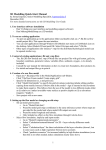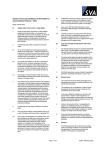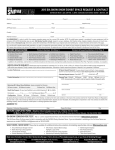Download Testing anaesthetic machines, ventilators and related equipment
Transcript
MAINTENANCE AND REPAIR OF LABORATORY AND HOSPITAL EQUIPMENT
4. Remove the drum-actuating lever and withdraw the drum. (If the drum is
seized or cannot readily be withdrawn, remove the locking ring from the gas
outlet and turn the adjusting ring in a clockwise direction to force the drum
out.)
5. Examine the drum for signs of scoring or corrosion; remove the old grease and
apply a film of a suitable grease.
6. Remove the drum-grease injector cap and clean all the old grease from the
body assembly.
7. Unscrew the plunger-control-gland packing nut, probe out the packing cotton
and regrease it. Replace the cotton and the gland-packing nut.
8. Insert the drum and refit the actuating lever.
9. W ith the outlet-adjusting ring removed, screw in the inlet adjusting ring,
while moving the actuating lever to and fro, until an increase in resistance to
lever movement is felt. (Do n ot overtighten the ring to the point of drum
seizure, as this will force out all the grease.)
10. W ithout moving the adjusting ring, fit and tighten the inlet locking ring.
11. Screw in the outlet adjusting ring until it just touches the drum, then back off
one-eighth of a turn; fit and tighten the locking ring.
12. Check the drum for freedom of operation.
13. Fill the grease-injector cap with grease and screw in to the grease point.
14. Examine the glass bottle for dirt and damage; replace as necessary.
15. Examine the U-tube and cowl for dirt and damage, and for security of
attachment.
16. Examine the bottle-sealing washer for serviceability; replace as necessary.
17. Examine the cork stopper for serviceability and security of attachment to the
retaining chain.
18. Refit the
vaporizer into the back-bar unit assembly.
19. Using a continuity test-set, or multimeter, check that there is electrical
continuity between the drum-actuating lever, the cowl-operating plunger, and
the vaporizer body.
20. Test the back-bar for leaks. See p. 94 for the back-bar tests.
Testing anaesthetic machines, ventilators and
related equipment
Anaesthetic machines and ventilators should be tested in the room or area where
the equipment is situated, if at all possible. Service personnel must wear accepted
operating-room clothing in the surgical areas.
Contact the person responsible for operating-room equipment regarding the
movement or servicing of any such equipment.
Anaesthetic machines
Tools and materials required
Normal service tools
Silicone grease
Light o il1
Service manuals
Watch with a second-hand
Spare parts
'D o not use o rd in a ry o il (such as m o to r o il) to lu b ric a te any p a rts th a t co m e into co n ta ct w ith
oxyg en.
ANAESTHETIC AND RESUSCITATION EQUIPMENT
Mercury sphygmomanometer
Anaesthetic gas analyser (if available)
Device for measuring flow, pressure and tidal volume
Testing procedure
If there is an official service manual, follow the steps outlined in it; otherwise,
follow the procedure below (see Fig. 4.5, page 75).
• Check for leaks in the high-pressure system:
1. Turn off all flowmeters, and disconnect any ancillary equipment such as
ventilators and suckers.
2. Turn on each cylinder in turn and allow the system to pressurize, then turn
the cylinder off. W atch the pressure gauge; if the needle drops, there is a
leak.
3. Remove the covers and brush each joint, or suspect point, with soapy water.
D o not forget to check inside the back of the pressure gauge. A leak will be
indicated by the formation of bubbles. D o this for each cylinder in turn.
• Check the operation of each flowmeter. M ake sure the control knob stays
where it is set, and is not liable to be turned by mistake.
1. Close all valves on the machine. Open all cylinder valves one full turn,
noting any movement of the flowmeter floats. Float movement indicates a
leaky flowmeter valve. If so, adjust the stop so that gas flow ceases l/8 turn
before the knob reaches the stop.
2. Verify flowmeter accuracy ( + 2 .5 % full scale), with the measuring device
connected to the common gas outlet.
3. Check that the needle-valve stems are tight enough to remain where set
unless deliberately turned by the operator.
• Check the low-pressure system, which is the part from the control knobs to the
outlet.
1. Check the top and bottom seals on the flow tubes with a low-pressure test.
— Connect a mercury sphygmomanometer to the outlet.
— Turn on the oxygen flowmeter very slowly.
— Pressurize the back-bar to 30 mmHg (4 kPa). W hen this pressure is reached
turn down the flow until the pressure on the gauge remains constant at
30 mmHg (4 kPa).
— If the flow is less than 100 ml/min, it is acceptable; if it is greater than this,
look for a leak.
2. Check all the joints on the back-bar with a high-pressure test.
— Pressurize the system to 150 mmHg (20 kPa).
— Reduce the flow to maintain that pressure.
— If the flow is 100 ml/ min or less, it is acceptable; if it is greater than this,
look for a leak. Brush each suspect point with soapy water; bubbles will
appear at the site of the leak.
• Check the correct operation of the oxygen-failure warning whistle (if fitted).
Pressurize the intermediate system, turn off the supply, and open the oxygenflowmeter valve to reduce the pressure slowly. The whistle should sound for a
minimum of 10 seconds when the pressure falls to between 180 and 250 kPa.
Check that the flow of nitrous oxide is cut off when the oxygen is turned off (if
that system is fitted).
• Check the oxygen-flush valve. It should allow a flow greater than 35 litres/min,
but not more than 75 litres/min (or as required by local regulations).
93
MAINTENANCE AND REPAIR OF LABORATORY AND HOSPITAL EQUIPMENT
• If there are hoses for connection to a wall supply, check these. Check the
oxygen flow from the oxygen flow tube when the oxygen probe is plugged in
and the nitrous oxide disconnected. Similarly, when the nitrous oxide probe is
plugged in and the oxygen disconnected, nitrous oxide must flow from the
nitrous oxide flow tube, and nothing from the oxygen flow tube.
• Check the non-return valve on each of the yokes. Pressurize the system, turn off
the cylinder, and remove it. There should be no gas leak. If there is a leak, look
for the simple non-return valve in the yoke. Dismantle and clean the valve, then
reassemble.
• If the anaesthetist has been having difficulty in getting patients to sleep, or
waking them up, there may be a problem with the vaporizer. Inspect the
mountings and connectors to ensure that they are secure and leak-free. W hen
servicing vaporizers, be sure to keep them in an upright position when they
contain liquid anaesthetic. To check the vaporizer, an anaesthetic gas analyser is
required. Connect the gas analyser to the common gas outlet. Set the oxygen
flow to 3 litres/min, and after zeroing the gas analyser with 1 0 0 % oxygen, test
each vaporizer at each full percentage setting. Determine that there is no
concentration of gas when the vaporizers are in the “off" position. Replace any
vaporizer for which the concentration is incorrect by more than 0 .3 % of the
reading, or 1 0 % of the measured value, whichever is greater. If an anaesthetic
gas analyser is not available, you can only check (a) that the vaporizer is off
when it is turned off, (b) that it gives an output when it is turned on again, and
(c) that the concentration of gas increases as the control is turned up.
Check that the control knob turns smoothly. Vaporizers should be returned to
the manufacturers, or their agents, for checking every few years. The interval
depends upon the model; some models need a check by the company only
every 10 years.
• Check the smooth operation of the pressure gauges. The pointer should move
smoothly and come to rest before the flow in the flow tube stops. If the
movement is not smooth, lubricate the linkage in the back with silicone grease.
• Check the absorber. Check for smooth operation of the controls and for leaks.
Change the filling if required.
• Check any other back-bar-mounted equipment.
• Check the output pressure of the regulators. This should be around 390 kPa (or
as required by local regulations), and in any case should be about 35 kPa lower
than the output pressure from the wall outlet.
• Check all flexible tubing on the machine.
• Check all attached equipment, such as suckers and blood pressure machines.
• Check the drawers, wheels, and the general frame of the machine. Lubricate
lightly as required.
• Clean the machine.
• Tick off all tests on the service sheet, and sign it.
• Return the machine to the user. The doctor in charge should test it to make sure
that it operates satisfactorily.
Ventilators
Tools and materials required
Normal service tools
Silicone grease
Light oil
Service manuals (if available)
W atch with a second-hand
Spare parts (if available)
Device for measuring flow, pressure and tidal volume
94
ANAESTHETIC AND RESUSCITATION EQUIPMENT
Testing procedure
It is of the utmost importance that all ventilators should work safely, since lives
depend upon their correct operation. In addition, ventilators should n ever be used
without a correctly adjusted alarm system, which gives a warning, and therefore
protects the patient, in case of malfunction or disconnection.
If you do not have the service manual for your machine, make every effort to get
one. M ake sure a service manual is ordered with every new machine. Even without
the manual, it is still possible to ensure that the machine is working correctly, but
the proper spare parts must be available. Records are very important when
maintaining ventilators and other life-support equipment. All reported faults,
repairs, and service details should be noted down, dated, and signed. Machines
should be serviced twice a year.
If you are called to look at a machine that has been reported as faulty, check first
that it has been set up properly. M ost reported faults are caused by operator error.
When looking for a fault, start from the beginning. For example, is the electricity
turned on? Is the gas on? Investigate the device in a planned manner, looking for
the obvious things first. If you have doubts about the machine's safety or correct
operation and you are unable to repair it on the spot, take it out of service. If there
is no spare machine, the patient must be ventilated with a resuscitation bag while
the machine is being repaired.
If it is not possible to repair a machine properly owing to a lack of spare parts, do
not be tempted to carry out temporary repairs. Report the problem to the user, ask
for the spares, and remove the machine from use.
Do not agree to put a machine back into service against your better judgement. If
the personnel on the ward insist, get them to sign the service sheet (with the
problem clearly stated).
Follow the steps outlined in the official service book. To carry out a service
without the book, follow the steps outlined below:
1. Inspect the outside of the machine, including all tubing, connectors, and any
bellows for damage. Replace as required. Lightly rub any antistatic tubing, or
bellows, with silicone grease to prevent perishing.
2. Connect up to the electricity and gas supplies, as required. Put a stopper or
test lung on the patient connector and start the machine running. Set the
controls to normal settings. W atch that the operation is regular and smooth.
Listen and check for any unusual noises. It is important to use the same regular
settings in each test; in this wray, you will get to know the normal movements
and sounds of correct operation. Any unusual movements or sounds will alert
you to possible problems.
3. Switch off and disconnect the machine from the mains. Remove the covers.
Inspect any internal tubing or bellows, lightly rub any antistatic tubing or
bellows with silicone grease to prevent perishing. Replace as required. Blow
clean, and wipe the insides. If there are electronic circuit boards, check that
they are secure and show no damage. Check for wear in any moving
mechanical parts. Using a light m otor oil, or similar, lightly lubricate any
moving pivot points. Clean up any drips.
4. Start the machine running again, taking care not to touch any internal parts;
watch any internal movements (bellows, lever, or valve movements) for
smooth operation.
5. Try each control in turn and check that it does what is intended; for example, if
the breath-rate control says that the machine will do 60 breaths per minute,
this must be confirmed. W ith all these checks, a degree of common sense is
95
MAINTENANCE AND REPAIR OF LABORATORY AND HOSPITAL EQUIPMENT
6.
7.
8.
9.
10.
11.
12.
necessary. For example, do not worry if the breath-rate control says 60 and
only 58 are delivered. Every machine has a margin of error. If the manual is not
available, a degree of discretion should be used.
Check that the pressure gauge is accurate by comparing it with a test gauge.
Check the correct operation of all lights and indicators.
To check the correct operation of the oxygen mixer, an oxygen analyser is
needed. If your department does not have one, ask the Anaesthetic Depart
ment to provide such an instrument. Note down on the service sheet the
output results from 2 1 % to 1 0 0 % .
Check the alarm system.
Run the machine again on the normal settings and check that it is still working
correctly.
If it is a machine that uses electricity, give it a safety check.
Fill out the service check-sheet, and sign it.
As you gain more experience in servicing, you will get to know which errors are
minor, and can be allowed, and which are unacceptable. For example, an oxygen
mixer on a paediatric ventilator must not give higher levels of inspired oxygen
than indicated. This is because very serious damage can be done to the infant's
eyes as a result.
Return the machine to the user; the doctor in charge should test it to ensure that it
operates satisfactorily.
Ventilator bellows
Mechanical integrity
Inspect the bellows housing and base for cracks, chips, etc. Check the tubing and
control knobs for tightness.
Over-pressure valve
Check the valve, located on the scavenging tee at the back of the control unit, for
cleanliness and operation.
Pop-off valve
Remove the housing, bellows, and pop-off valve from the base. Check that the
pop-off valve, glass disc, and seat are clean and dry, and that the retaining screw is
tight.
Bellows flexibility
Reassemble the ventilator and connect the test gauge to the common gas outlet.
Inflate the bellows to 0.1 litre. If the pressure is above 1.75 cm water (1.3 mmHg)
then the bellows should be replaced.
Bellows pressure (low)
Connect the device for measuring pressure to the common gas outlet, open the
oxygen flowmeter to 300 ml/min, and allow the bellows to rise to the top. The
pressure should be less than 2.5 cm water (1.84 mm Hg or equivalent on the gauge
in use), and the bellows should remain full. If the bellows do not remain up, or the
pressure exceeds 2.5 cm water, then refer to the ventilator service manual for the
necessary repairs.
Bellows pressure (high)
Connect the common gas outlet to the driving gas port on the bellows, and plug
the bellows outlet. Pressurize the outside of the bellows to just above 60 cm water
96
ANAESTHETIC AND RESUSCITATION EQUIPMENT
(44 mmHg) and maintain an oxygen flow of 3 0 0 ml/min. The pressure gauge
should settle at or above 60 cm water. If the pressure drops below 60 cm water,
refer to the ventilator service manual for the necessary repairs.
Ventilator controller
Low-oxygen-supply alarm
Check that the low -oxygen alarm activates before the supply pressure to the
ventilator drops below 250 kPa, and resets when the pressure reaches 320 kPa.
Low-airway-pressure alarm
Check that the alarm activates if the pressure measured at the patient port remains
below 7 cm water (5 mmHg or equivalent on the gauge in use) for between 20 and
30 seconds.
Safety valve
Check that the relief valve opens when the pressure in the patient circuit exceeds
65—75 cm water (48—55 mmHg or equivalent on the gauge in use).
Flow delivery
Set the ventilator as follows:
minute volume
10
rate
10
inspiratory: expiratory (I: E) ratio 1 :1
Start the ventilator; the tidal volume measured with a spirometer, or ventilator
tester, should be between 0.9 and 1.1 litres/min. If it is not, first check the rate with
a stopwatch and adjust if necessary. Check the I : E ratio with a stopwatch at a very
low rate, and adjust if necessary. After confirming that both are correct, reset the
ventilator to the above settings and adjust the minute volume to give a 1 litre tidal
volume.
Absorbers
Canister
Check for cracks and chips, and check gaskets. Replace as necessary.
Inspiratory and expiratory valves
Inspect the inspiratory and expiratory valves for cleanliness, and for bent or
chipped discs.
Bag/ventilator switch (if fitted)
Inspect the valve, clean, and lubricate with silicone grease, as necessary, to
maintain free action.
Relief valve
Inspect, clean, and lubricate screw-threads with silicone grease. Check that when
the valve is fully open a maximum pressure of 0.3 kPa (2.5 mm H g) is maintained in
the system with the oxygen flowmeter opened to flood measured with the device
for measuring flow, pressure and tidal volume at the bag connector.
97
MAINTENANCE AND REPAIR OF LABORATORY AND HOSPITAL EQUIPMENT
Drain valve
Inspect and clean as necessary.
Elevating assembly
Check that the push-button operates smoothly; raise and lower the assembly
several times to check operation. If it does not operate smoothly, disassemble and
clean with alcohol. D o not lubricate.
Compound pressure gauge
Test the patient pressure gauge for zero setting and accuracy ( + 5 % of reading)
with the pressure-measuring device attached to the bag connector. Calibrate, if
necessary, with the adjusting screw located under the plug-screw, inside the
absorber head, beneath the screen.
Pressure regulators (reducing valves) and
flow m eters
The pressure regulator, or reducing valve, as the name suggests, is used to reduce
the pressure of a gas from the cylinder pressure to a pressure that is safe for
subsequent delivery to a patient. For example, in the case of oxygen, it is from
14 30 0 to 420 kPa. A flowmeter can be attached to the regulator to allow a given
flow to be set. These assemblies are most common on anaesthetic machines, or on
an oxygen therapy unit attached to the top of a gas cylinder.
W hen used in oxygen therapy1, there are three parts to the unit:
— a gauge showing the pressure of the contents of the cylinder,
— a regulator to reduce the pressure,
— a flowmeter that indicates the selected flow.
There are a number of different designs of regulator, but generally each unit has
one inlet (from the cylinder) and three outlets, one to the pressure gauge, one to
the flowmeter, and one to the blow-off valve. It is important to know which one is
meant to be connected to the pressure gauge: do not connect any other part to this
outlet.
W hile the proper checking of pressure regulators requires some special test
equipment, most problems can be overcome with very little equipment.
Remember that the flow tube is under regulator pressure. D o not unscrew it before
the cylinder is turned off and the pressure released.
Setting the output pressure
Make sure that the cylinder contents gauge and the safety valve are connected to
the regulator, remove the flowmeter and fit in its place a 0 —700 kPa pressure
gauge. Connect the regulator to the gas cylinder, and turn on the gas. The test
pressure gauge should show a reading of 4 2 0 kPa. This is the correct pressure for
an oxygen therapy regulator and flowmeter. If it is not 4 2 0 kPa, adjust with a
socket head key until it is correct. If you are adjusting the pressure downwards,
you must release the pressure from the test gauge, turn the adjusting screw out,
not use any o il w hen re p a irin g oxyg en re g u la to rs . If you use PTFE o r p lu m b e rs ’ tap e, you
sh o u ld use o n ly s p e c ia l d e -g re a s e d tape.
98
ANAESTHETIC AND RESUSCITATION EQUIPMENT
reconnect the test gauge, and adjust the pressure up to 420 kPa. O n most makes,
the adjustment screw will be found at the end of the piece which sticks out at the
front; it may be covered with a sticky label.
At this pressure, it should be possible to obtain a flow of up to 55 litres/min out of
the unit; this is called the flush flow. In some places, the regulator is not set for
pressure but adjusted for a given flow with the control wide open; check what is
required before adjusting the setting.
For a regulator attached to an anaesthetic machine, adjust the pressure to about
390 kPa (30 kPa lower than the pressure from the pipeline supply to the machine).
Testing a regulator and flowmeter unit
1. Check for leaks.
2. Check that the pointer on the gauge works smoothly and reaches the stop
before the flow falls to zero.
3. Check that the flow goes to its full rate.
Faults
•
If a leak is suspected, check as follows:
— W ith the flowmeter unit turned off, turn on the gas and allow the pressure to
rise. Turn off the gas supply.
— The system is now pressurized to the full cylinder pressure, but with a very
small volume.
— If there is any leak, the gauge will show a fall in pressure; the bigger the leak
the faster the fall.
— If the pressure falls, brush the unit with soapy water; any leaks will show up
as small bubbles.
— Do not forget to check inside the back of the gauge.
•
Leaks around the bull-nose connector are
Replace the ring.
• Leaks at the blow-off valve:
usually caused by a
faulty O-ring.
— First, check that the regulator is set to the correct output pressure.
— If the pressure rises to more than it should, yet the regulator is set to the
correct output pressure, there is a faulty valve seat (a problem called "creep").
Replace the valve seat.
The blow-off valve should normally go off at about 640 kPa.
• If the flowmeter makes a popping noise when the flow is turned on ("motor
boating"), there is probably dirt inside the valve; the noise may also be caused
by a faulty valve seat.
• Low flows: unscrew the needle valve and check that it is clean and undamaged.
• If the ball, or bobbin, shows a small flow even when the unit is turned off, check
the flow tube for leaks.
• If the gauge needle does not drop smoothly, remove the back of the gauge and
lubricate the movement of the gauge with a light watch oil. Use of oil is
acceptable in this case, as there is no oxygen flowing in this part.
• If there is no flow, even when the gauge shows that there is gas in the cylinder,
this suggests that the gauge needle is stuck. Check the movement in the back of
the gauge,, or reposition the needle on the shaft.
Unregulated flowmeters, in which the flowmeter is connected directly to the gas
cylinder, are dangerous and should not be used.
99
MAINTENANCE AND REPAIR OF LABORATORY AND HOSPITAL EQUIPMENT
Oxygen analysers
Inspection and calibration
Visually inspect the cables and the display unit for signs of wear or deterioration.
Check that the sensor membrane is not nicked or otherwise damaged, and that the
O-ring seal is intact. Test the calibration by first placing the sensor in a T-adaptor,
in a verified 1 0 0 % oxygen line, and allow the readings to stabilize. If, after 3
minutes, the display has not stabilized, replace the sensor. If it has stabilized, adjust
the CALknob, if necessary, so that the display registers 1 0 0 % . Remove the sensor
from the T-adaptor and expose to room air. A reading of 2 1 % ( + 2 % ) should be
displayed within 1 minute. If a correct reading is not displayed, replace the sensor.
100


















